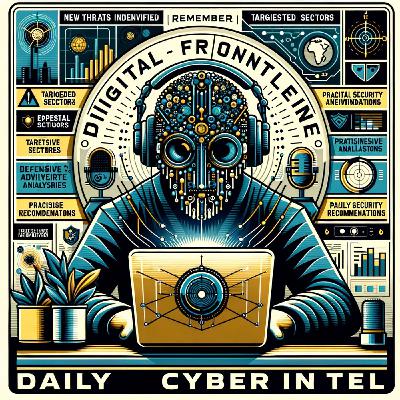China's Cyber Surge: AI Attacks, Digital Booby Traps, and a Hacked US Struggling to Keep Up!
Update: 2025-11-05
Description
This is your Digital Frontline: Daily China Cyber Intel podcast.
Hey listeners, Ting here with your Digital Frontline: Daily China Cyber Intel, and wow, what a wild 24 hours it’s been. If you thought things were quiet, think again. The F5 breach fallout is still unfolding, and according to GovInfoSecurity, the US government is still struggling to contain the fallout from what’s almost certainly a Chinese-instigated hack. Furloughs and staffing shortages are making it harder to respond, and that’s not a good combo when we’re talking about critical infrastructure.
Now, let’s talk about what’s new. The McCrary report just flagged a fresh wave of Chinese cyber tactics, warning specifically about Typhoon cyber threats targeting US critical infrastructure. These aren’t just random probes—they’re coordinated, sophisticated, and they’re hitting sectors like energy, water, and transportation. The report notes that these attacks are designed to disrupt, not just to spy, so if you’re in any of these industries, you need to be on high alert.
On the defensive side, the US is pushing hard on cyber deterrence. According to the Stimson Center, the focus is on credible cyber deterrence, which means not just blocking attacks but making it clear that there will be consequences. Pre-positioning—where attackers plant code in networks for future use—is a big concern. It’s like leaving a digital booby trap, and it’s a tactic China’s been experimenting with more and more.
Experts are also warning about the rise of AI-powered attacks. China’s been using generative AI for influence operations and narrative-building, and there are reports that Chinese hackers are using AI to make their attacks more efficient. Deepfakes, AI-assisted coding, and AI-powered hacking tools are all on the table. The sheer volume of these threats is overwhelming, especially for IT, education, and government sectors.
So, what should you do? First, patch everything. Second, monitor your networks for unusual activity, especially around critical infrastructure. Third, train your staff to spot AI-generated phishing attempts. And finally, keep your incident response plans up to date.
Thanks for tuning in, and don’t forget to subscribe. This has been a quiet please production, for more check out quiet please dot ai.
For more http://www.quietplease.ai
Get the best deals https://amzn.to/3ODvOta
This content was created in partnership and with the help of Artificial Intelligence AI
Hey listeners, Ting here with your Digital Frontline: Daily China Cyber Intel, and wow, what a wild 24 hours it’s been. If you thought things were quiet, think again. The F5 breach fallout is still unfolding, and according to GovInfoSecurity, the US government is still struggling to contain the fallout from what’s almost certainly a Chinese-instigated hack. Furloughs and staffing shortages are making it harder to respond, and that’s not a good combo when we’re talking about critical infrastructure.
Now, let’s talk about what’s new. The McCrary report just flagged a fresh wave of Chinese cyber tactics, warning specifically about Typhoon cyber threats targeting US critical infrastructure. These aren’t just random probes—they’re coordinated, sophisticated, and they’re hitting sectors like energy, water, and transportation. The report notes that these attacks are designed to disrupt, not just to spy, so if you’re in any of these industries, you need to be on high alert.
On the defensive side, the US is pushing hard on cyber deterrence. According to the Stimson Center, the focus is on credible cyber deterrence, which means not just blocking attacks but making it clear that there will be consequences. Pre-positioning—where attackers plant code in networks for future use—is a big concern. It’s like leaving a digital booby trap, and it’s a tactic China’s been experimenting with more and more.
Experts are also warning about the rise of AI-powered attacks. China’s been using generative AI for influence operations and narrative-building, and there are reports that Chinese hackers are using AI to make their attacks more efficient. Deepfakes, AI-assisted coding, and AI-powered hacking tools are all on the table. The sheer volume of these threats is overwhelming, especially for IT, education, and government sectors.
So, what should you do? First, patch everything. Second, monitor your networks for unusual activity, especially around critical infrastructure. Third, train your staff to spot AI-generated phishing attempts. And finally, keep your incident response plans up to date.
Thanks for tuning in, and don’t forget to subscribe. This has been a quiet please production, for more check out quiet please dot ai.
For more http://www.quietplease.ai
Get the best deals https://amzn.to/3ODvOta
This content was created in partnership and with the help of Artificial Intelligence AI
Comments
In Channel





